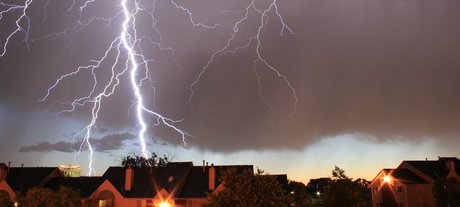Protection pays — guarding against lightning and surges

Lightning strikes are inevitable, so it’s important to make sure your facilities and equipment are appropriately protected.
Picture the scene: you’re a public utility, and you’re in the middle of refurbishing one of your facilities. Half the work is completed and staff have moved back in, while the other half is still to be finished. You can see the light at the end of the tunnel. But then, all of a sudden, light of a different kind breaks through. A lightning bolt smashes into your building, sending hundreds of thousands of volts coursing through the facility and its surroundings.
Lucky for you that you had lighting and surge protection, right? Well, half right. You see, this scenario actually occurred with a water utility in Queensland. During the refurbishment, half of the facility had received surge protection, while in the other half of it had yet to be installed. Equipment in the former half was completely protected, while in the latter half there was major damage.
“There was no damage to the board” in the protected half of the building, says Peter Burnett, business development executive at Novaris. It was the company’s surge diverters which had saved that part of the facility. “And even in the area where a lot of the equipment was damaged, there was no damage to the supply or circuit breakers, which to me suggests it came up through the earth. It just fried the equipment that was plugged in.”
That’s the thing about lightning protection — it’s not always a case of direct strikes. Sometimes the surge comes up the earth wire from the ground following the lightning strike.
“They had building protection in terms of lightning rods, but a lightning rod will only take a strike to ground,” says Burnett. “The problem is that with an earth stake, you actually give a path upwards for the surge into the building. And so anything connected to the earth, then, is subject to a surge.
“In fact, that’s how I got hit by lightning myself,” he says with a laugh. “When I was a kid at home, the house got hit and — you know those old gramophones? — I was putting records on, I had my finger on top of the stack… and I woke up on the other side of the room.
“So the fact that you have an earth doesn’t mean that you’re immune to lightning strikes,” he adds. “And it’s also one of the reasons why a cheap surge diverter often is very ineffectual. Because as soon as you breach the breakover voltage — and for your average plastic, that’s around 1500 V — it’s going to go straight through it like a hot knife through butter. And so it can come up the earth very, very easily, and then ‘bang’.”

Burnett says that a good lightning protection system will clamp everything so that you end up with a voltage no larger than around 700–800 V for the micropeak. Novaris filters clamp to less than 360 V.
The thing about good lightning protection, though, is that it can’t do the impossible — that is, stop a strike.
“I think most people are ignorant of the need for surge and lightning protection — they are two different things,” says Burnett. “What you have to do is control where the power dissipates, and so by controlling where it goes, you can choose to protect whatever part of your hardware you want to. And so surge protection is not surge omission; it is surge redirection, really.”
There are three levels of protection. Surge diversion is the lowest, followed by series surge, and then surge filtering is the best bet.
“The second way, series surge, is where you put both the active and the neutral through the surge diverter, and it doesn’t rely on the installer because the cable lengths on both the active and the neutral are controlled,” says Burnett. “But the device has to carry the entire power, and so it gives you a lower let-through than a straight surge diversion.
“A proper surge filter will actually give you a surge diversion, plus it’ll give you harmonic filtering on your power line. And it gives you a lower let-through voltage when a strike hits,” says Burnett.
Customised rugged tech shaping the next era of defence comms
Rugged computing platforms are becoming central to how armed forces protect communication...
A guide to aquatic survival this summer
While most Australians are planning aquatic adventures this summer, less than a third are...
Maher Terminals enhancing operations with private wireless
Maher Terminals chose the Nokia Edge platform because it needed a secure, reliable,...



